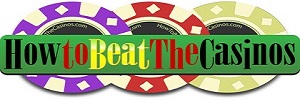Bankroll Mastery: How Pros Stay In the Game While Others Go Broke
G’day again—it’s Dave the Gambler from HowToBeatTheCasinos.com, and today we’re talking about something that every gambler thinks they understand… but most don’t: bankroll management.
I just finished watching a YouTube video that broke down how professional gamblers build and maintain their bankroll. And let me tell you, the way a pro treats their money is completely different from the way your average weekend punter does.
See, most folks walk into the casino with $300 in their pocket and one goal: to turn it into $3,000. They treat gambling like a get-rich-quick mission. And sometimes it works… but mostly it doesn’t. Because they haven’t built a bankroll—they’ve brought a budget for disaster.
Let’s talk about what a real bankroll strategy looks like and why it’s the biggest difference between winners and losers.
What Is a Bankroll, Really?
Let’s define it properly. Your bankroll isn’t just the cash in your pocket on Friday night. It’s your dedicated gambling fund—money set aside specifically for betting. Not rent money. Not grocery money. Not the kid’s soccer fees.
It’s money you can afford to lose—and it’s meant to stretch, not disappear after one bad session. A pro sees the bankroll as their lifeblood. Their goal isn’t to double it in one hit. It’s to preserve it long enough to let the odds, skills, or advantages they have pay off over time.
The 5 Bankroll Rules the Pros Follow
I took some notes from that video and compared them to my own experience. Here are the five rules I reckon every gambler should follow—especially if you want to stop gambling emotionally and start gambling smart.
1. Set a Real Bankroll Limit
Let’s say you want to gamble regularly—maybe once a week or every couple of weeks. You decide to dedicate $2,000 as your gambling bankroll. That’s not just for tonight—that’s for the long haul. Divide it up into “sessions,” like $200 per visit. That way, you can play ten times before it runs out, even if you lose each session.
That’s what pros do. They think in long timelines, not short thrills.
2. Use Units, Not Emotions
A “unit” is your base bet amount—say, $10. A pro calculates how many units they have in their bankroll. So with $2,000 and $10 units, you’ve got 200 units.
Then you decide what games or bets deserve 1 unit, 2 units, or more. You don’t just “feel” like betting $100 on a hunch. You stay within a system. That’s what keeps the wolves from the door when the luck runs cold.
3. Flat Betting > Chasing
Professionals rarely chase losses. You won’t catch them doubling and tripling bets to get even. Instead, they flat bet. That means consistent bet sizes, with occasional raises only when things are going well—and even then, it’s controlled.
Why? Because long-term, flat betting keeps variance manageable. Emotional chasing destroys bankrolls faster than any bad spin ever could.
4. Set Session Limits
This one’s critical: pros don’t try to win back-to-back-to-back every time they play. They have stop-loss limits and win goals.
Maybe they say, “If I lose 10 units, I walk.” Or “If I win 20 units, I’m done for the day.” That discipline is what turns a random good night into a steady winning pattern over time.
5. Track Every Dollar
Real gamblers treat this like a business. They track results. Not just wins and losses, but game type, hours played, number of units risked, and ROI.
That’s not nerdy—that’s essential. If you don’t know your numbers, how will you ever know if what you’re doing works?
Why Casual Gamblers Lose the Bankroll Battle
Here’s what most casino punters do:
- Bring $200
- Play $5 pokies with max bet ($5 per spin)
- Hit a bonus, keep going
- Lose everything in 30 minutes
- Pull out the card for another $100
- Walk away empty and grumpy
There’s no plan. No stop-loss. No structure. Just chaos in digital form.
And even worse? When they win, they don’t protect it. They let it ride until they’re back to zero, all because they “felt lucky.” Pros take wins off the table. They lock in profits, take breaks, and protect their stake.
But Dave, Isn’t That Boring?
Mate, I get it. There’s something thrilling about going all-in, chasing a jackpot, or dumping a few hundred into a slot and hoping the next spin pays for dinner. But that’s not gambling. That’s donating.
Real gambling is the art of staying in the game long enough to win. You can still have fun—but your fun doesn’t have to end in regret.
I’ve had wild nights, sure. But my best memories? Walking away with profit, not stories about how I almost hit the bonus.
Bankroll Tips for Different Games
Here’s how I personally tweak my strategy depending on what I’m playing:
- Slots: Play lower volatility games if you’ve got a small bankroll. Take breaks between spins. Use stop wins religiously.
- Blackjack: Stick to 1–2% of your bankroll per hand. Avoid progressive betting unless you’ve got serious cushion.
- Craps: Focus on Pass Line + odds. Budget for at least 20 bets per session.
- Roulette: Play even-money bets only. Stay consistent and walk after 2–3 wins or 5 losses.
- Poker: Have at least 20 full buy-ins for the stakes you play. Never enter a game with scared money.
Final Thoughts
Here’s the truth: you can’t beat the casino every time—but you can beat yourself. You can beat the urge to go too big. You can beat the impulse to chase. You can beat the bad habits that leave most gamblers with empty wallets and full regret.
The difference between a punter and a pro isn’t luck. It’s structure. A plan. A bankroll that’s respected, not abused.
So the next time you walk into a casino, ask yourself: Am I managing a bankroll… or just burning through cash?
Play smart, play long, and keep the edge where it belongs—in your corner.
Until next time,
—Dave the Gambler

